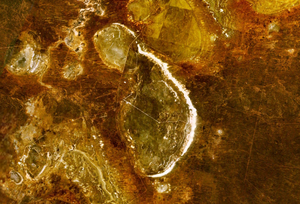Lake Mungo
Lake Mungo is a dry lake in the south-western part of New South Wales, Australia. It is about 760 km due west of Sydney[1] and 90 km north-east of Mildura. The lake is the main feature of Mungo National Park. It is one of 17 lakes in the World Heritage listed Willandra Lakes Region.

Many important archaeological discoveries have been made at the lake. This includes Mungo Man, the oldest human remains found in Australia,[2] and Mungo Lady, the oldest human remains in the world to be ritually cremated.
It is also the site of the Lake Mungo geomagnetic excursion, the first convincing evidence that Geomagnetic excursions are a geomagnetic phenomenon rather than sedimentological.[3]
Geology
changeSediments at Lake Mungo have been deposited over more than 100,000 years. On the eastern shore of the lake are the 'Walls of China'. These are a 26 km long series of lunettes, about 30 metres high, formed over thousands of years. There are three distinct layers of sands and soil forming the Walls. The oldest is the reddish Gol Gol layer, formed between 100,000 and 120,000 years ago. The middle greyish layer is the Mungo layer, deposited between 50,000 and 25,000 years ago. The most recent is the Zanci layer, which is pale brown, and was laid down between 25,000 and 15,000 years ago.
The Mungo layer, which was deposited before the last ice age period, is the most archaeologically rich. It was a time of low rainfall and cooler weather, but more rainwater ran off the western side of the Great Dividing Range, keeping the lake full. It supported a large human population, as well as many varieties of Australian megafauna.
During the last ice age period, the water level in the lake dropped, and it became a salt lake. This made the soil alkaline, which helped to preserve the remains left behind in the Walls of China. Although the lake completely dried up several thousand years ago, ground vegetation remained on the Walls. This which helped to stabilise them and preserve them. With the arrival of European settlers in the area in the 1880s, introduced species, mostly rabbits, sheep and goats have destroyed the vegetation cover. This has led to increased erosion of the dunes. However, this erosion has led to the uncovering of many human and animal remains. Wind has moved sand and soil eastwards from the Walls, forming a mobile sand dune which moves further east every year.
Archaeology
changeThe most important findings at Lake Mungo have been Mungo Man and Mungo Lady. Mungo Lady, a partly cremated body, was discovered in 1969 by Dr Jim Bowler from the Australian National University (ANU). At first she was thought to be 25,000 years old. A more recent study in 2003 found that she was probably closer to 40,000 years old. Mungo Lady is the earliest known human to have been cremated. Mungo Man was also discovered by Dr Bowler, on 26 February 1974. The remains were covered with red ochre, in what is the earliest known incidence of such a burial practice. Although some studies have shown his age at more than 60,000 years, the current agreement is that he is also about 40,000 years old.
Humans have been living around Lake Mungo for at least 50,000 years. Stone tools have been found in the dunes which are older than the Mungo Man. Grinders for making flour have been found which are between 5,000 and 10,000 years old; they were made of sandstone sourced from the
Murray River basin 100 km away. A stone axe head, at least 500 years old, was also found in the dunes; it was made from stone from Mount Camel, near Shepparton, well over 300 km away.
The rich archaeological heritage of the site is very significant to the Aboriginal Australian people from the area. The Willandra region is home to the Barkindji, Nyiampaa and Mutthi Mutthi people. They have Joint Management Agreements with the Government of New South Wales to manage the lake and the Mungo National Park.
Lake Mungo Geomagnetic Excursion
changeIn 1972, Archaeomagnetic studies were carried out on the prehistoric aboriginal fireplaces found along the ancient shoreline of Lake Mungo. Magnetization preserved in oven-stones and baked hearths show that the axial dipole field moved up to 120 degrees from its normal position around 30,000 years ago. This is called a geomagnetic excursion. Because most of the excursions found before Lake Mungo were in sedimentary material, it had been thought that the magnetic field directional anomalies were detrital or diagenetic in origin. The Lake Mungo results were due to thermoremanent magnetization, ruling out a sedimentological phenomena.[3]
Two excursions have been recorded in sediments from Skjonghelleren on Valderøy, Norway. The Virtual Geomagnetic Pole (VGP) of one happened at the same time as Lake Mungo which suggests the event was global rather than local. Data from lake sediments of a similar age in France having near identical magnetic field lines also support Lake Mungo being a global event. However, it has been suggested that Lake Mungo's anomalous field is the result of lightning strikes.[3]
References
change- ↑ "Distance calculator Sydney to Lake Mungo". Geoscience Australia. Archived from the original on 2011-06-05. Retrieved 2008-03-27.
- ↑ "New age for Mungo Man, new human history : Media Releases : News : The University of Melbourne". Archived from the original on 2005-06-22. Retrieved 2014-04-03.
- ↑ 3.0 3.1 3.2 Jacobs, J.A. (1994). Reversals of the Earth's Magnetic Field. Pg. 94 - 96: Cambridge University Press. ISBN 9780521450720.
{{cite book}}: CS1 maint: location (link)